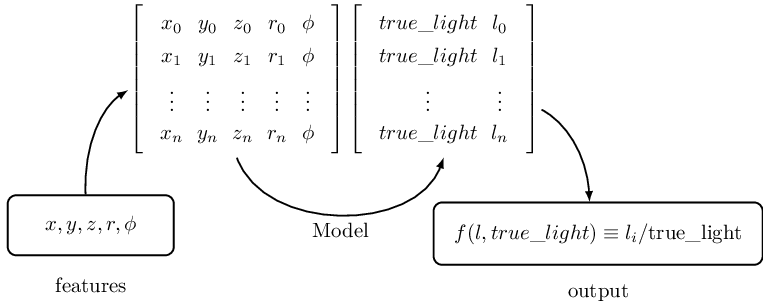Illustration of functional map
This is a diagram I used to explain the functional model made using Machine Learning library to understand positional characterstics of an arbitrary function.

\tikzset{
state/.style={
rectangle, rounded corners, draw=black, thick,
minimum height=2em, minimum width=8em, inner sep=10pt,
text centered
}
}
\begin{tikzpicture}[>=latex, line width=0.75pt]
\begin{scope}
\node[state] (modelo1) {$x,y,z,r,\phi$};
\node[below of=modelo1] {features};
\node (m1) [above right of=modelo1, node distance=3.5cm,
matrix of math nodes, left delimiter=[,right delimiter={]}]
{
x_0 & y_0 & z_0 & r_0 & \phi\\
x_1 & y_1 & z_1 & r_1 & \phi\\
\vdots & \vdots & \vdots & \vdots & \vdots \\
x_n & y_n & z_n & r_n & \phi\\
};
\node (m2) [right of=m1, node distance=3.5cm,
matrix of math nodes, left delimiter=[,right delimiter={]}]
{
true\_light & l_0 \\
true\_light & l_1 \\
\vdots & \vdots \\
true\_light & l_n \\
};
\node (modelo2) [below right of=m2, state, node distance=3.7cm]
(modelo2) {$f(l,true\_light) \equiv l_i/\text{true\_light}$};
\node[below of=modelo2] {output};
\path[->, shorten >=1em] (modelo1) edge[bend left=30] (m1.west);
\path[->] (m1.south) edge[bend right=70]
node [midway, below] {Model} (m2.south);
\path[<-, shorten >=1em] (modelo2) edge[bend right=30] (m2);
\end{scope}
\end{tikzpicture}